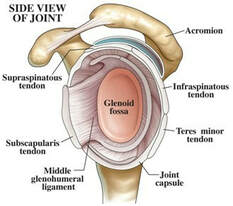Start by scheduling your appointment today!
Shoulder Pain | Your Rancho Cucamonga Chiropractor for Shoulder Pain
Shoulder pain is one of the most common complaints seen by your chiropractor. Shoulder pain may arise from the shoulder joint itself or from many surrounding muscles, ligaments or tendons. Various movements of the shoulder may cause increased pain and indicate that the pain is arising from the shoulder joint itself. Common conditions of the shoulder that may require treatment from your chiropractor include:
- Rotator cuff injuries
- Bursitis
- Frozen shoulder
- Impingement
- Osteoarthritis
- Shoulder dislocations
- Sprains/strains
- Tendinitis
- Collarbone (AC joint) injuries
Common conditions that may cause shoulder pain:
BursitisBursitis is the inflammation of small sacs containing synovial fluid called bursae or bursa, that lie within tissue where friction would occur. Bursae rest at points in the body where muscle and tendons slide across bone. They allow for smooth frictionless gliding, making movement painless. When bursitis occurs, movement over the bursae becomes difficult and painful. Movement will then aggravate the existing inflammation and perpetuate the injury, leading to muscle stiffness and increased pain. The cause of bursitis is most often due to repetitive movement and excessive pressure on the structures of the body. Shoulders, elbows and knees are the most commonly affected structures. Bursitis is most often diagnosed through physical examination and treatment option are available in order to decrease pain and improve recovery times.
|
Tendonitis
|
Tendonitis is inflammation of a tendon which joins muscle to bone. The most common cause of tendonitis is the over use of structures through repetitive motion. This repetitive motion leads to injury in the tendon or
muscle. Tendonitis can occur following a strain or tear of a muscle which has not been allowed to heal properly. Tendonitis injuries are common in the upper and lower extremities and are less common in the hips and torso. The severity of tendonitis is solely dependent on the frequency and type of exercise or use. Symptoms of tendonitis include tenderness directly over the tendon, pain with movement and swelling surrounding the tendon. Tendonitis is always diagnosed through physical examination and treatment options are available in order to decrease inflammation and improve structural function of the body. |
Strains and Sprians
|
A strain is a term given when there is damage to a muscle or tendon, more commonly known as a pulled muscle. Typical symptoms include localized stiffness and discoloring or bruising around the area of injury. Strains are a result of muscular-fiber tears due to over stretching of a muscle. They can happen during normal sports activity and are very painful when occur. Recovery from a muscle strain is dependent on the severity of the injury. A muscle strain is often graded 1 through 3. In grade 1 or mild muscle strains, the muscle or tendon is over stretched and small tears to the muscle occur. There is mild pain without swelling to the affected area. In grade 2 or moderate muscle strains, the muscle or its tendon are over stretched with more of the fibers torn but not complete. Symptoms include marked pain with swelling and tenderness over the area of injury. Bruising may occur due to damage of small blood vessels at the site of injury. In grade 3 or severe muscle strains, the most serious among the three grades, muscle fibers are completely torn or ruptured. Pain, swelling, tenderness and bruising are most often always present and movement is difficult. Muscle strains are diagnosed based of the mechanism of injury and through physical examination of the patient. Please consult with our doctors if you have suffered a strained muscle.
|
A sprain is an injury in a joint caused by over stretching of ligaments that surround the affected structures. Ligaments are though, fibrous tissues that connect bone to bone. Sprains can occur in any joint, but are most common in the ankle and wrist. Symptoms include pain, swelling, bruising and decreased movement in the affected limb. If there is a rupture of a ligament, a popping sound is often heard. Sprains are diagnosed through physical examination and their severity is dependent on the mechanism of injury and appearance. Sprains are graded from 1 to 3 similar to strains. In a grade 1 sprain, there is slight stretching and some damage to the fibers of the ligament. In a grade 2 sprain, there is partial tearing of the ligament with marked looseness (laxity) of the joint occurs. In a grade 3 strain, there is complete tearing of the ligament with gross instability and laxity in the joint.
Treatment for Shoulder Pain with Chiropractic Care in Rancho Cucamonga
Contact us now for a your first visit with Dr. Jimmy Sayegh at Elevate Chiropractic in Rancho Cucamonga, Ca and see how chiropractic can change your life today!





